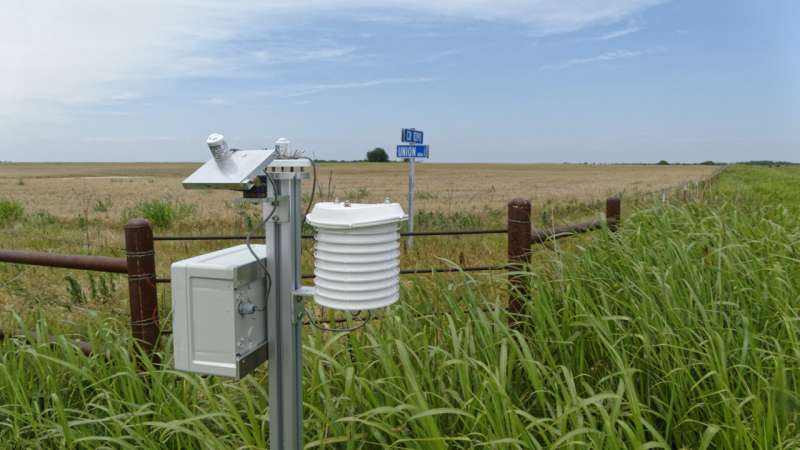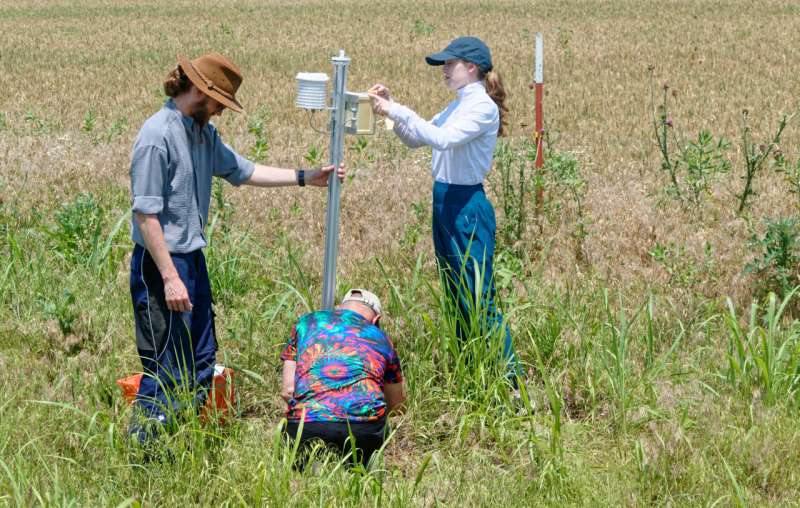This article has been reviewed according to Science X's editorial process and policies. Editors have highlighted the following attributes while ensuring the content's credibility:
fact-checked
proofread
Measurement campaign on small-scale variability of solar radiation: Overview and first results

For the first time, German researchers have measured the influence of clouds on short-term fluctuations of solar radiation in North America. They have used a globally unique network of radiation sensors that was designed and built at the Leibniz Institute for Tropospheric Research (TROPOS), which has been deployed in the flat prairies of the Midwest of the U.S. from the beginning of June until the end of August this year.
So-called pyranometers have recorded the incoming sunlight at 60 locations distributed over an area of 6x6 square kilometers in the US state of Oklahoma with second precision. The researchers from Leipzig have measured in the direct vicinity of the Southern Great Plains (SGP) Atmospheric Observatory, the world's largest and most comprehensive observatory for atmospheric radiation.
The "Small-Scale Variability of Solar Radiation" (S2VSR) measurement campaign by TROPOS, the US radiation measurement program ARM, and the University of Oklahoma has successfully collected important climate data at the Earth surface. The planned scientific analysis of this data aims for a more efficient use of the latest generations of weather and environmental satellites and photovoltaic systems, and to make weather forecasts and climate models more accurate.
These measurements complement the data sets obtained during six previous field campaigns in Germany and in the Arctic since the construction of this network 10 years ago.
For this campaign, not only the prevailing meteorological conditions are of interest, but also the extensive possibilities for comparison with routine measurements at the site of the observatory and in the entire state of Oklahoma, namely the comprehensive atmospheric measurements of the ARM program and the Oklahoma MESONET.
The TROPOS pyranometer network has supplemented these with information on fluctuations on the second and decameter scale, which the routine measurements cannot provide due to the too-large distances between stations.
The data will now serve as a basis for comparisons with the latest satellite observations: on the one hand, with the American geostationary GOES-R satellite, which already provides observations with 500m resolution every 5 minutes, similar to those of the European METEOSAT satellites of the third generation expected for the end of this year; and on the other hand, with the European Sentinel-2 mission, with images of up to 10 meters spatial resolution.

The field campaign relied on the logistical support and very good cooperation with the American Atmospheric Radiation Measurement (ARM) program. ARM is focused on the study of the atmosphere and its interactions with atmospheric radiation, and has operated the observatory in Oklahoma since 1992. Another important partner for the campaign and the planned scientific analysis of these observations is the School of Meteorology at the University of Oklahoma.
It is the largest meteorology department in the United States and is traditionally better known for its severe weather research. But it has made a significant shift in the last 8 years to a broader atmospheric research program. "The collaboration on the S2VSR measurement campaign offers excellent opportunities for our CL2EAR (CLouds ClimatE Aerosols Radiation) research group," says Prof. Jens Redemann, Director of the School of Meteorology.
"Through S2VSR, our students have gotten "hands-on" training in handling and data analysis of this unique network of pyranometers that could provide the key to many questions in our research field. We hope for a long and comprehensive collaboration between TROPOS and OU Meteorology."
"During the 12-week campaign, two measurement stations were damaged by mowing activities, and only one could be repaired. In the course of the routine maintenance, occasional impairments of the measurements were found due to dirty or tilted pyranometers. However, the preliminary quality assurance of the collected data shows that the overall quality and availability is very high even in comparison to past campaigns, and that the campaign was a great success."
"Here, the commitment of the students of the University of Oklahoma for the maintenance needs to be emphasized in particular," reports Dr. Hartwig Deneke from TROPOS
The scientific analysis of the Small-Scale Variability of Solar Radiation (S2VSR) campaign data, which will now begin, will aim for new insights into the short-term fluctuation of sunlight at the Earth's surface as caused primarily by clouds.
"On these scales, effects in atmospheric radiative transfer are dominated by the 3-dimensional structure of clouds, which so far is insufficiently taken into account by current weather and climate models as well as in satellite-based products. We hope that in the medium term, the gained insights will also contribute towards improving short-term forecasts of sunlight for the optimal use of renewable energy generated by photovoltaics," explains Dr. Hartwig Deneke.
More information: Presentation details: c-in.floq.live/event/iugg2023b … ac7492d1&type=detail
Provided by Leibniz Institute for Tropospheric Research (TROPOS)



















